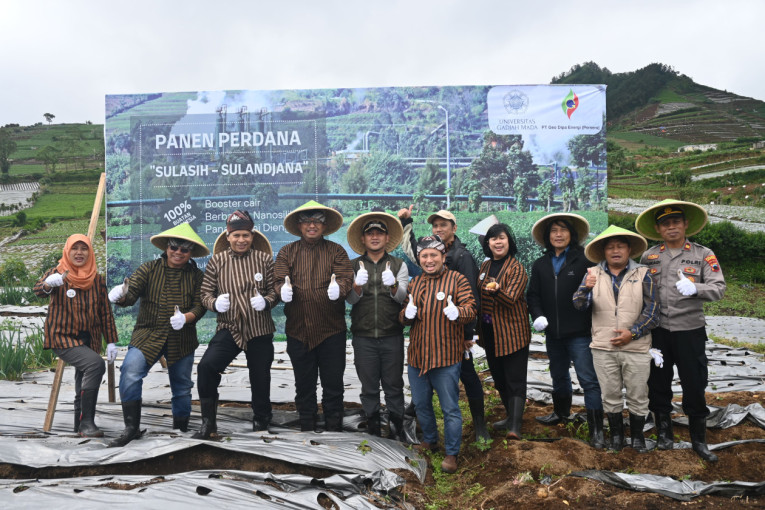
A research team from Universitas Gadjah Mada (UGM) at the Geothermal Research Center, Faculty of Engineering (FT UGM), consisting of experts including Dr. Pri Utami, a geothermal geology specialist, Dr. Ronny Martien, a nanobiotechnology expert, Dr. Wiratni, a bioprocess engineering expert, and Dr. Ngadisih, a soil and water conservation expert, along with researchers from PT Geo Dipa Energi, led by Herdian, has successfully developed a liquid booster to enhance agricultural fertility in the highlands of Dieng using silica sediment, which has been a byproduct from geothermal power plants.
The booster is named “Sulasih-Sulanjana,” after deities associated with fertility and plant protection. According to the lead researcher, Dr. Utami, the name reflects local wisdom expressed in traditional Lengger dance songs about managing resources while preserving nature.
“We chose the name from deities associated with plant fertility,” said Dr. Utami in a statement sent to journalists on Friday (Jul. 5).
Dr. Utami, a lecturer in Geological Engineering at FT UGM, explained that geothermal brine, operated by PT Geo Dipa Energi (Persero) to supply 60 MW of electricity to the Java-Bali grid, is reinjected into the geothermal reservoir after energy extraction.
However, the brine in Dieng contains high concentrations of silica and other substances as byproducts of geothermal energy.
“Silica forms sediments that have been considered waste,” she explained.
Research revealed that silica and its accompanying elements benefit plants by enhancing growth and resistance to pests.
“Our team processes silica and other beneficial elements with nanoparticulate technology into an environmentally friendly liquid booster ready for application in Dieng’s plantations,” she added.
Following trials on agricultural land in Dieng, a first harvest was conducted on July 5, coinciding with PT Geo Dipa Energi (Persero) ’s 22nd anniversary.
The harvest was carried out at a potato demonstration plot in partner farmers’ fields in Krajan Hamlet, Banjarnegara, Central Java.
The harvest was led by the Dean of FT UGM, Professor Selo, along with PT Geo Dipa Energi’s Director Yudistian Yunis, Batur District Head Aji Piluroso, village heads, partner farmers from all over Batur, and community leaders.
The event featured local cultural elements, including the Lengger dance and songs emphasizing the synergy between various interests in achieving mutual prosperity and harmony with nature.
The first harvest event also included an educational session on the synergy between geothermal energy development and advancing sustainable agriculture through the Wayang Cinema “Sulasih-Sulanjana,” produced by Dr. Citra Aryandari, a member of the Geothermal Research Center at FT UGM from the Indonesian Institute of Arts (Yogyakarta).
Dean Selo and Director Yudistian Yunis appreciated the research team’s innovation, noting that creating natural fertilizers and boosters from geothermal “waste” represents a breakthrough in environmental preservation.
Dr. Ngadisih, another research team member, mentioned that the silica-based booster is expected to significantly reduce the use of manure, which can produce foul odors, damage soil microbiology, and decrease dependence on chemical fertilizers and pesticides.
“In the future, the Sulasih-Sulanjana booster will be applied to various horticultural crops in the Dieng Plateau,” Dr. Ngadisih said.
The Dieng Plateau in Central Java, known for its tourism and vegetable production, is rich in geothermal energy sources for power generation and is situated amidst local plantations.
As Indonesia’s unique renewable energy resource, the liquid booster from geothermal byproducts could become a leading product, reflecting the synergy between energy companies and academics focused on sustainable agricultural development.
Author: Gusti Grehenson

